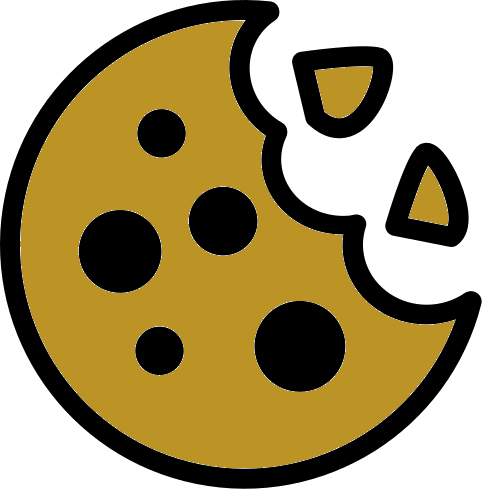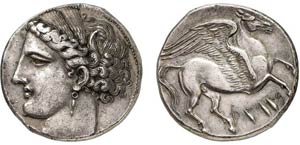- Home
- Numismatic Auction 8
- 22 Zeugitania - Carthage. 5 shekels, ca. 260 BC, uncertain ...
Lot 22 - Numismatic Auction 8
Bids
Description
Zeugitania - Carthage. 5 shekels, ca. 260 BC, uncertain mint in Sicily. Obv. Head of Tanit-Persephone left, wearing barley wreath and earring. Rev. Pegasus flying right; below, «b’rst» (in the Land) in Punic characters. Kraay/Hirmer 211; G.J. Jenkins, Coins of the Punic Sicily, part. IV, SNR 57, 1978, n° 442 (03/R11). AR 37.95 g.
Ch XF* Strike 5/5 Surface 5/5 NGC
Ex. Lanz auction 54, 12 november 1990, lot 358.
This exceptional silver decadrachm of Carthage was struck at the beginning of the war effort of the first Punic war against Rome. It was struck in Sicily using the traditional Punic standards and not the Attica standard, as used earlier in coins issued locally by the Carthaginians. The reverse shows Pegasus flying to the right and has no links with the Punic iconography. It is styled after Corinthian staters that were widely circulating in Sicily during the time, and which were resumed in Syracuse during the reign of Agathocles (317-289). Even the portrait on the obverse of Tanit-Persephone tends to be closer, in its particular style, to that of Arethusa. However, by its weight, general appearance as well as the striking technique, this Carthaginian “Decadrachm” is much different from those issued nearly a century and a half earlier in Sicily. Its low relief and the flat and thinner planchets used for these coins are clearly different than many of the other Greek coins of the time. Its style and quality makes this coin an emblematic part of Carthaginian numismatics, which alone perfectly illustrates the singularity and characteristics of the Punic style.
Cette exceptionnelle monnaie d’argent carthaginoise remonte aux débuts de l’effort financier causé par la première guerre punique contre Rome. Elle est frappée en Sicile selon l’étalon punique traditionnel et non plus attique, comme auparavant pour les monnaies émises sur place par les Carthaginois. Son type de revers, Pégase volant à droite, est sans lien avec l’iconographie punique. Il rappelle celui des très nombreux statères corinthiens qui circulent depuis longtemps en Sicile ; il est repris par Syracuse dès le règne d’Agathocle (317-289). Le portrait même de Tanit-Perséphone tend à se rapprocher, par ses attributs notamment, de celui d’Aréthuse. Cependant, tant par son poids, son aspect général, que par les techniques de sa frappe, ce « décadrachme » carthaginois ne ressemble guère à ses prédécesseurs émis près d’un siècle et demi plus tôt en Sicile. Son relief est bien plus bas car le flan employé est manifestement plus mince. Son module et ses spécificités en font une pièce emblématique de la numismatique carthaginoise, une pièce qui, à elle seule, illustre parfaitement la singularité si caractéristique du style punique.
Please use the registration form to send us your participation request, or, if you are already registered and authorized, use the login box on the top.
For any information please contact info@cfnumis.com
Categories
Auction: Numismatic Auction 8
Timetable
Pre-bidding - End
04 07 2017 17:00 CEST
Room auction - Start
05 07 2017 15:00 CEST
Information
Contacts
Avenue du Mail, 15, Genève, 1205, Switzerland
 Respecting your privacy is our priority
Respecting your privacy is our priority
This site uses cookies to improve user experience and to collect information on the use of the site. You can read our cookie policy, accept all cookies and continue browsing by clicking on "Accept" or customize your choice by clicking on "Customize".
Cookie Policy
Cookies
To make this site work properly, we sometimes install small data files called "cookies " on your device. Most of the big sites do the same.
What are cookies?
A cookie is a small text file that websites save on your computer or mobile device while you visit them. Thanks to cookies, the site remembers your actions and preferences (for example login, language, font size and other display settings) so that you do not have to re-enter them when you return to the site or browse from one page to another.
How do we use cookies?
Third party cookies
Google Analytics
This site uses Google Analytics to collect information about the use of users of its website. Google Analytics generates statistical and other information through cookies, stored on users' computers. The information generated relating to our website is used to make reports on the use of websites. Googl
How to control and modify cookies?
You can modify or withdraw your consent at any time from the cookie declaration on our website.
Privacy Policy
Find out more about who we are, how you can contact us and how we process personal data in our privacy policy .
The necessary cookies help to make the website usable by enabling basic functions such as page navigation and access to protected areas of the site. The website cannot function properly without these cookies.
| Name | Supplier | Purpose | Expiry |
|---|---|---|---|
| cookieConsent | Bid Inside | Stores the user's cookie consent status for the current domain | 6 months |
| PHPSESSID | Bid Inside | Preserve the user's status in the different pages of the site. | When the browsing session ends |
| f_display | Bid Inside | The f_display cookies memorize the display mode chosen by the user in the pages where there are lists | When the browsing session ends |
| f_page | Bid Inside | The f_page cookies store the page viewed by the user in the pages where there are lists | When the browsing session ends |
| f_rec_page | Bid Inside | The f_rec_page cookies store the number of elements to be displayed per page chosen by the user in the pages in which there are lists | When the browsing session ends |
| f_order_by | Bid Inside | The f_order_by cookies store the sorting parameter selected by the user in the pages where there are lists | When the browsing session ends |
| f_order_dir | Bid Inside | The f_order_dir cookies store the ordering direction chosen by the user in the pages where there are lists | When the browsing session ends |
| watch_list_show_imgs | Bid Inside | The watch_list_show_imgs cookie stores the user's choice to show or hide lot images on the watch list page | When the browsing session ends |
| selected_voice | Bid Inside | The selected_voice cookie stores the voice selected by the user for the speech synthesis present in the live auction | 1 Month |
| include_autobids | Bid Inside | The include_autobids cookie stores the user's choice to show or hide their auto-bids on the 'Your bids' page | 6 months |
Analytical cookies help to understand how visitors interact with the website, collecting and transmitting statistical information to the Data Controller.
| Name | Supplier | Purpose | Expiry |
|---|---|---|---|
| _ga | Register a unique ID used to generate statistical data on how the visitor uses the website. | 2 years | |
| _gat_gtag | Used by Google Analytics to limit the frequency of requests | 1 day | |
| _gat | Used by Google Analytics to limit the frequency of requests | 1 day | |
| _gid | Register a unique ID used to generate statistical data on how the visitor uses the website. | 1 day | |
| __utma | Bid Inside | Used to distinguish users and sessions. The cookie is created when the javascript library executes and no existing __utma cookies exists. The cookie is updated every time data is sent to Google Analytics. | 2 years |
| __utmt | Bid Inside | Used to throttle request rate. | 10 minutes |
| __utmb | Bid Inside | Used to determine new sessions/visits. The cookie is created when the javascript library executes and no existing __utmb cookies exists. The cookie is updated every time data is sent to Google Analytics. | 30 minutes |
| __utmc | Bid Inside | Not used in ga.js. Set for interoperability with urchin.js. Historically, this cookie operated in conjunction with the __utmb cookie to determine whether the user was in a new session/visit. | When the browsing session ends |
| __utmz | Bid Inside | Stores the traffic source or campaign that explains how the user reached your site. The cookie is created when the javascript library executes and is updated every time data is sent to Google Analytics. | 6 months |
| __utmv | Bid Inside | Used to store visitor-level custom variable data. This cookie is created when a developer uses the _setCustomVar method with a visitor level custom variable. This cookie was also used for the deprecated _setVar method. The cookie is updated every time data is sent to Google Analytics. | 2 years |
Preference technical cookies allow a website to remember information that affects the way the site behaves or presents itself, such as your preferred language or the region you are in.
We do not use cookies of this type.Profiling cookies are used for marketing purposes, to monitor website visitors. The intent is to display relevant and engaging ads for the individual user.
We do not use cookies of this type.Unclassified cookies are cookies that are being classified, together with individual cookie providers.
We do not use cookies of this type.




 23
23